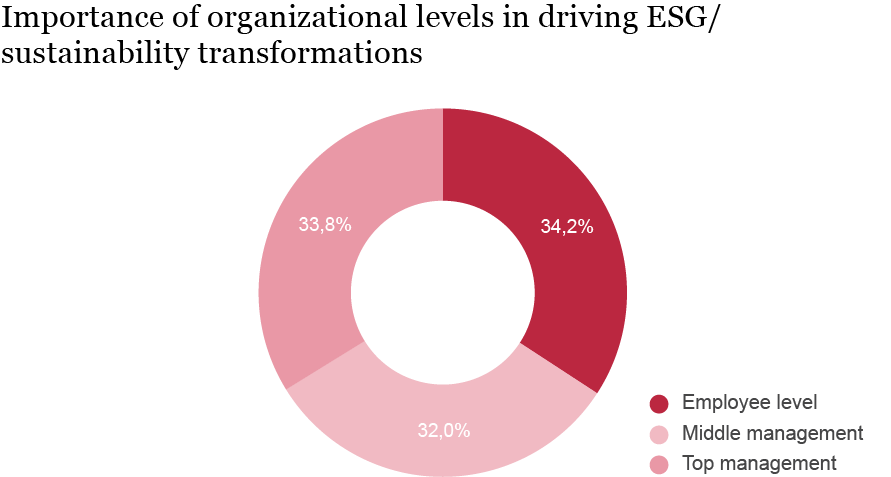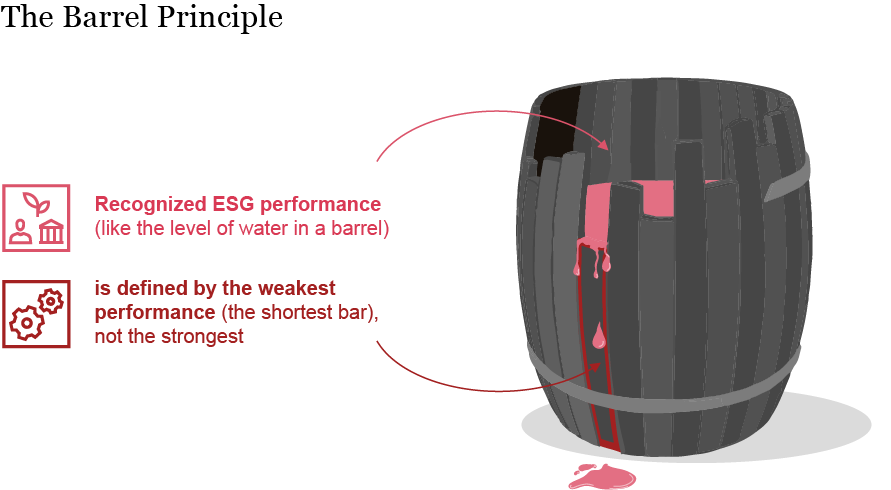Key drivers and actions that can ensure organizations fully embrace ESG values and behaviors
Cultural change is essential for the success of an ESG transformation. Without it, organizations will likely fail to integrate environmental, social and governance considerations into every aspect of their business, facing resistance from management and employees. Yet executing and embedding cultural change across the organization is a complex task, precisely because it requires buy-in from the C-suite to the shop floor and realignment of the entire workforce to an ESG “true north”.
This paper defines what ESG cultural change means and identifies the key actions that organizations should take to achieve it. Our analysis is grounded in a survey we conducted with 1,050 employees in ESG-related roles at organizations in Germany, the UK, and the US. We asked them for their views on ESG issues ranging from the importance of leadership behaviors to the key levers for driving transformation at an employee level.
Overall, 84% of respondents said cultural change was relevant in achieving successful ESG transformations and 80% believe that both senior leadership and employees have a critical role to play. Our findings confirm that ESG culture can be described along three main dimensions:

- Authentic: New values, behaviors and initiatives must reflect an organization’s authentic identity to take root and be coherent with the organization’s strategy
- Transparent: Continuous, open communication regarding the case for change and progress to date is essential to create a common sense of purpose
- Inclusive: Leaders must involve all employees at every stage of the ESG journey by listening to their needs and concerns and providing timely feedback
As our survey results highlight, the most successful ESG cultural changes are driven from both the top and the bottom of organizations. Senior management should set the direction and lead by example, while employees must embrace and incorporate ESG values and behaviors into their daily work. Middle management also has an important role in driving ESG changes – not least because a successful transformation can only be achieved with the whole organization on board and moving in the same direction.
During the transformation journey, it is critical that leaders pay close attention to how the changes are affecting all levels of their organization and understand what matters most to their employees. Leaders should also be aware that different aspects of ESG will have varying relevance to individuals, depending on their role and seniority. In that sense, there is no one-size-fits-all model for executing change. At the same time, all ESG aspects must be integrated into the journey, because otherwise there is a risk that some employees will be left behind. If that happens, the ESG transformation will be defined by the weakest rather than the strongest performance.
Defining ESG cultural change
In their recent book “Beyond Digital”, Strategy& experts Paul Leinwand and Mahadeva Matt Mani demonstrate that even the best digital initiatives are no longer sufficient to gain a competitive edge. To succeed today and in the future, organizations need to create new forms of compelling value that go beyond digitizing, or only optimizing for financial value. ESG fits this need perfectly, in an age of increasing concern about climate change, social fairness and corporate governance. For example, 79% of respondents to PwC’s 2021 Global Investor Survey considered that ESG risks and opportunities were important factors when making investment decisions, while half (49%) said they would sell their holding in a company if it failed to address ESG issues adequately.
There is no one-size-fits-all pathway for ESG cultural change. Nonetheless, all successful ESG cultural change programs share the same common guiding principles. In the first place, the potential added value of an authentic ESG culture to an organization explains why it is critical to define what it means; a lot is at stake, even just in terms of corporate self-interest. In the broadest sense, culture is “the self-sustaining pattern of behavior that determines how things are done,” according to Jon Katzenbach of Strategy&’s Katzenbach Center. Applying this definition, a robust ESG culture will inform the development of strategic possibilities and how long they will take to implement.
This is of course easier said than done. Our survey provided us with a wide range of insights about how an ESG culture can be effectively introduced and sustained. The findings support our analysis that organizations should initially define and reinforce the few critical behaviors that are consistent with the new ESG strategy. In addition, the overwhelming consensus among respondents is that lasting cultural change must be driven from both the bottom and the top of an organization. A successful cultural change program depends on combining both these strands.

At the same time, ESG cultural change must be comprehensive, penetrating all areas of a business, including governance, operations, remuneration and communication. Achieving this goal requires a commitment of financial and human resources from the outset to kick start the process. As a related PwC publication observed, “the connection between strategy and culture has to be embedded in the management system and the allocation of resources, because together these support the decisions to invest in the critical few behaviors that disproportionately drive performance”.
What is true of cultural change generally also holds for ESG culture: it cannot simply be willed into existence without management’s full backing.
Key drivers and actions that enable ESG cultural change in organizations
All ESG cultural change should be implemented across four dimensions to align the ESG-integrated strategy with the organization’s authentic identity:
- Governance und top-down steering
- Bottom-up pressure
- Values and behaviors
- Key performance indicators (KPIs) and insights
Within these dimensions, more than 80% of our survey respondents regard the following areas for driving ESG cultural change as relevant:
- Transparency regarding the reasons for ESG cultural change and its impact
- Better governance, with top-down steering and control
- Encouraging bottom-up pressure
- Promoting the most important ESG values and behaviors
- Building on the strengths of the existing culture
- Clearly defined ESG KPIs supported by incentive systems
We recommend that organizations should focus on the following areas to drive ESG cultural change in the most effective and rapid way:
Governance and top-down steering
A “lack of attention or support from leadership” ranked high on the list of barriers to ESG effectiveness in a PwC executive survey. It is not enough for corporate leaders merely to pay lip service to what employees tell them about the need to embrace a new ESG culture. Senior management has to “walk the talk” so that everyone in the organization is willing to contribute to the achievement of relevant ESG KPIs.
The opposite is also true. Effective governance and top-down steering will help drive ESG cultural change, as one example from a recent Strategy& paper on the ESG revolution illustrates. The CEO and COO of a North American utility developed a simple slogan to describe the costly shift they envisioned from coal- and gas-powered plants to wind- and solar-powered ones. They reported that the slogan helped galvanize the organization and educate investors about the long-term financial benefits of their strategy as alternative energy economics improve.
This kind of strong management commitment and effective top-down steering is essential to cascade ESG down to all levels and anchor it in culture and behaviors through clear expectation management, adherence to quality standards, and uniform goals and ambitions. Based on Strategy&’s flagship study, Empowered Chief Sustainability Officers, CSOs can be central to this steering effort.
As we noted, CSOs with a presence in the C-suite and a broad remit have the potential to influence both ESG strategy and implementation across the entire organization. They can also help address concerns about ESG which many senior managers and board directors admit that they do not understand well. A CSO can also inform and upskill the executive team on evolving ESG issues.
Bottom-up pressure
Based on our survey feedback, several leadership behaviors motivate employees to engage in ESG sustainability transformations. More than 80% of respondents view the following dimensions as most relevant:
- Leading by example
- Involving employees at all levels
- Active listening and timely response
Leaders must bear in mind that to ensure success, they will need to pay close attention to the varying ESG preferences and priorities of employees. It may make sense, for example, to place greater emphasis on employee involvement at all levels, if this is seen by a significant number of people as deficient. However, it is still critical to cover all the dimensions, because if one of them is missing, the entire ESG transformation effort will be put at risk, on the “barrel principle”. If one wooden stave on a barrel is too short, all the barrel’s contents will leak; the entire barrel must be fit for purpose.

Leaders also need to be aware that in some organizations, one of the barriers to effective bottom-up pressure to introduce ESG culture is what can be defined as the “sticky middle”, describing the urge of preserving the status quo, often driven by middle management, which can often obstruct generally younger progressive advocates for ESG change at a more junior level. Overcoming this “sticky middle” is essential in order to ensure that corporate leaders receive ESG feedback and lobbying from the bottom of the organization loudly and clearly.
Values and behaviors
Successful ESG transformation requires a nurturing culture where organizations find the most effective ways to engage, motivate, reskill, and ultimately empower their employees. Based on our survey feedback, the most important values and cultural behaviors relate to responsibility (88%), trust and collaboration (84%) and innovation (84%).
By embedding ESG culture into every part of the organization, it will reflect the organization’s authentic identity, enabling innovation and clearing the path for a true integration of ESG into the corporate DNA. By contrast, separate ESG initiatives with specialist functional teams can often have a harmful effect by creating disconnected silos. The danger is that ESG becomes an easy box-ticking exercise to please various stakeholders, including customers and partners, without becoming central to ways of working and thinking – for example, through conducting ESG reviews for every individual project.
Establishing a dedicated ESG change network is a great way to support the organization’s transition by championing the ESG vision, encouraging engagement, and providing operational transition support. ESG change agents should include representatives from all internal stakeholder groups to ensure that all levels of the organization are reached and play a full role in integrating ESG initiatives.
An article published by ScienceDaily shows that up to 40% of what we do in an organization is habitual. Overall, therefore, companies engaged in ESG cultural change need to have a clear understanding of their current habits and analyze which of them fit their defined authentic identity. Habits that are not aligned should be discarded and replaced by new nurturing habits. Similarly, many organizations will need to get rid of capabilities that are not relevant to ESG cultural change and build new ones.
Key performance indicators (KPIs)
Performance management and KPIs featured strongly in our survey as a top driver of ESG cultural change. However, when implementing ESG cultural change, organizations need to put a stronger emphasis on a broad range of performance measures rather than focus on narrow financial and formal metrics alone. This is the consensus view of our survey, where more than 86% of respondents say that “learning and development” and “continuous communication and engagement” are relevant ESG drivers.
Within these general categories, each organization will require its own set of new transformation KPIs that reflect the level embeddedness of ESG in the organization. This may include KPIs such as quantity and quality of trainings, share of trained employees, usage of learning platforms and ESG intranet or level of innovation. However, in all cases, these customized KPIs should hold all levels of the organization accountable and not only senior management – for example, by adjusting employee incentives, compensation, and benefits.
Lastly, as with financial performance metrics, the secret of effective transformation KPIs is to keep them simple and focus on a few key elements. Full transparency is essential - the consensus view of 80% of our survey respondents.
Key actions to implement ESG cultural change
Now is the time to act, learning from initiatives that have already proved effective at other organizations. Based on our research and the survey findings, we recommend the following measures to implement and embed ESG cultural change:
- Walk the talk and continue to the achievement of cultural change, e.g., by implementing an effective governance and top-down steeringP
- ay close attention to preferences and priorities of employees in order to overcome the "barrel principle" and the corresponding "sticky middle"
- Cultivate a transformation-friendly culture by nurturing values and behaviors related to responsibility, trust and collaboration, and innovation
- Implement informal transformation KPIs that measure the process of the ESG cultural change
All these actions can aid in nurturing an ESG culture by engaging, training, and empowering employees, the cornerstone of all organizational cultures. Without their full, enduring support, ESG cultural change will not happen, blocking the road ahead for the ESG transformation journey.
Cindy Zhong, Marcel Bruch and Sebastian Geibig also contributed to this article.




